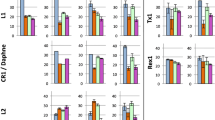Abstract
In the genome of the South African frog, Xenopus laevis, there are two complex families of transposable elements, Tx1 and Tx2, that have identical overall structures, but distinct sequences. In each family there are approximately 1500 copies of an apparent DNA-based element (Tx1D and Tx2D). Roughly 10% of these elements in each family are interrupted by a non-LTR retrotransposon (Tx1L and Tx2L). Each retrotransposon is flanked by a 23-bp target duplication of a specific D element sequence. In earlier work, we showed that the endonuclease domain (Tx1L EN) located in the second open reading frame (ORF2) of Tx1L encodes a protein that makes a single-strand cut precisely at the expected site within its target sequence, supporting the idea that Tx1L is a site-specific retrotransposon. In this study, we express the endonuclease domain of Tx2L (Tx2L EN) and compare the target preferences of the two enzymes. Each endonuclease shows some preference for its cognate target, on the order of 5-fold over the non- cognate target. The observed discrimination is not sufficient, however, to explain the observation that no cross-occupancy is observed – that is, L elements of one family have never been found within D elements of the other family. Possible sources of additional specificity are discussed. We also compare two hypotheses regarding the genome duplication event that led to the contemporary pseudotetraploid character of Xenopus laevis in light of the Tx1L and Tx2L data.
Similar content being viewed by others
References
Aksoy, S., S. Williams, S. Chang & F.F. Richards, 1990. SLACS retrotransposon from Trypanosoma brucei gambiense is similar to mammalian LINEs. Nucl. Acids Res. 18: 785–792.
Christensen, S., G. Pont-Kingdon & D. Carroll, 2000. Target specificity of the endonuclease from the Xenopus laevis non-LTR retrotransposon, Tx1L. Mol. Cell. Biol. 20: 1219–1226.
de Sa, R.O. & D.M. Hillis, 1990. Phylogenetic relationships of the pipid frogs Xenopus and Silurana: an intergration of ribosomal DNA and morphology. Mol. Biol. Evol. 7: 365–376.
Feng, Q., J.V. Moran, H.H. Kazazian, Jr. & J.D. Boeke, 1996. Human L1 retrotransposon encodes a conserved endonuclease required for retrotransposition. Cell 87: 905–916.
Feng, Q., G. Schumann & J.D. Boeke, 1998. Retrotransposon R1Bm endonuclease cleaves the target sequence. Proc. Natl. Acad. Sci. USA 95: 2083–2088.
Force, A., M. Lynch, F.B. Pickett, A. Amores, Y.L. Yan & J. Postlethwait, 1999. Preservation of duplicate genes by complementary degenerative mutations. Genetics 151: 1531–1545.
Gabriel, A., T.J. Yen, D.C. Schwartz, C.L. Smith, J.D. Boeke, B. Sollner-Webb & D.W. Cleveland, 1990. A rapidly rearranging retrotransposon within the miniexon gene locus of Crithidia fasciculata. Mol. Cell. Biol. 10: 615–624.
Garrett, J.E. & D. Carroll, 1986. Tx1: a transposable element from Xenopus laevis with some unusual properties. Mol. Cell. Biol. 6: 933–941.
Garrett, J.E., D.S. Knutzon & D. Carroll, 1989. Composite transposable elements in the Xenopus laevis genome. Mol. Cell. Biol. 9: 3018–3027.
Graf, J.-D. & H.R. Kobel, 1991. Genetics of Xenopus laevis, pp. 19–34 in Xenopus laevis: Practical Uses in Cell and Molecular Biology, edited by B.K. Kay and H.B. Peng. Academic Press, San Diego.
Hughes, M.K. & A.L. Hughes, 1993. Evolution of duplicate genes in a tetraploid animal, Xenopus laevis. Mol. Biol. Evol. 10: 1360–1369.
Jakubczak, J.L., W.D. Burke & T.H. Eickbush, 1991. Retrotransposable elements R1 and R2 interrupt the rRNA genes of most insects. Proc. Natl. Acad. Sci. USA 88: 3295–3299.
Kobel, H.R. & L. Du Pasquier, 1986. Genetics of polyploid Xenopus. Trends Genet. 2: 310–315.
Labrador, M. & V.G. Corces, 1997. Transposable element-host interactions: regulation of insertion and excision. Annu. Rev. Genet. 31: 381–404.
Luan, D.D., M.H. Korman, J.L. Jakubczak & T.H. Eickbush, 1993. Reverse transcription of R2Bm RNA is primed by a nick at the chromosomal target site: a mechanism for non-LTR retrotransposition. Cell 72: 595–605.
Martin, F., C. Maranon, M. Olivares, C. Alonso & M.C. Lopez, 1995. Characterization of a non-long terminal repeat retrotransposon cDNA (L1Tc) from Trypanosoma cruzi: homology of the first ORF with the Ape family of DNA repair enzymes. J. Mol. Biol. 247: 49–59.
Mol, C.D., C.-F. Kuo, M.M. Thayer, R.P. Cunningham & J.A. Tainer, 1995. Structure and function of the multifunctional DNA-repair enzyme exonuclease III. Nature 374: 381–386.
Rio, D.C., 1991. Regulation of Drosophila P element transposition. Trends Genet. 7: 282–287.
Teng, S.-C., S.X. Wang & A. Gabriel, 1995. A new non-LTR retrotransposon provides evidence for multiple distinct site-specific elements in Crithidia fasciculata miniexon arrays. Nucl. Acids Res. 23: 2929–2936.
Tymowska, J. & M. Fischberg, 1982. A comparison of the karyotype, constitutive heterochromatin, and nucleolar organizer regions of the new tetraploid species Xenopus epitropicalis Fischberg and Picard with those of Xenopous tropicalis Gray (Anura, Pipidae). Cytogenet. Cell Genet. 34: 149–157.
Villanueva, M.S., S.P. Williams, C.B. Beard, F.F. Richards & S. Aksoy, 1991. A new member of a family of site-specific retrotransposons is present in the spliced leader RNA genes of Trypanosoma cruzi. Mol. Cell. Biol. 11: 6139–6148.
Xiong, Y. & T.H. Eickbush, 1988. Functional expression of a sequence-specific endonuclease encoded by the retrotransposon R2Bm. Cell 55: 235–246.
Yang, J. & T.H. Eickbush, 1998. RNA-induced changes in the activity of the endonuclease encoded by the R2 retrotransposable element. Mol. Cell. Biol. 18: 3455–3465.
Yang, J., H.S. Malik & T.H. Eickbush, 1999. Identification of the endonuclease domain encoded by R2 and other site-specific, non-long terminal repeat retrotransposable elements. Proc. Natl. Acad. Sci. USA 96: 7847–7852.
Author information
Authors and Affiliations
Rights and permissions
About this article
Cite this article
Christensen, S., Pont-Kingdon, G. & Carroll, D. Comparative studies of the endonucleases from two related Xenopus laevis retrotransposons, Tx1L and Tx2L: target site specificity and evolutionary implications. Genetica 110, 245–256 (2000). https://doi.org/10.1023/A:1012704812424
Issue Date:
DOI: https://doi.org/10.1023/A:1012704812424




